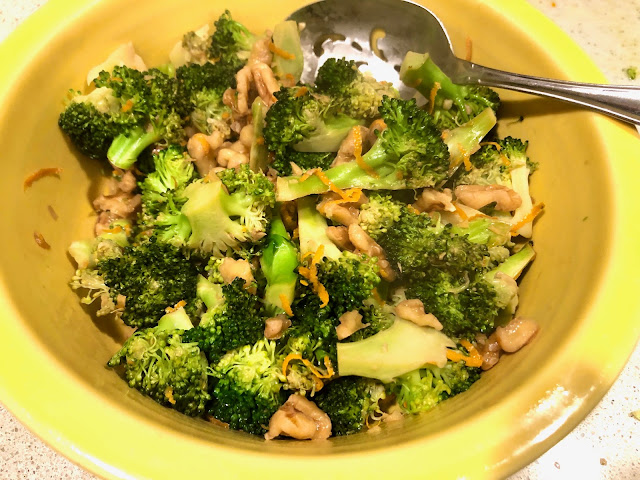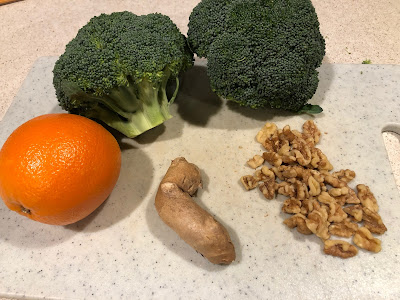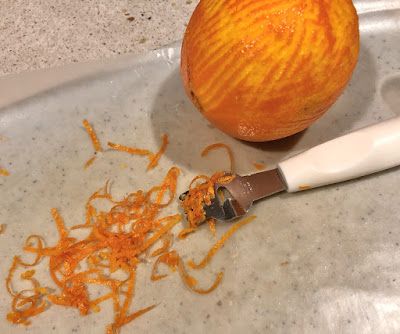
Recipe: Broccoli side dish is quick and delicious
 |
| Broccoli can be bright and fresh, really. (Photos: Kathy Morrison) |
Oranges and other citrus are a godsend in winter, when we need a dash of brightness, both in color and flavor. They're great in baked goods and salads, of course, but also in vegetable dishes, where the orange adds highlights without bumping up the calorie count.

|
This broccoli dish comes from a favorite source, "The Sunset Cookbook," the big one with the orange cover, published in 2010. The editors credit a reader, Laura A. Flynn, for creating this side, which speaks so much of California cooking: a few fresh seasonal ingredients, a little Asian influence and a light hand in the cooking. It's ready in less than 10 minutes once the ingredients are prepped. Keep the broccoli pieces fairly small so they cook quickly and the broccoli remains bright green.
Orange and walnut broccoli
Adapted from "The Sunset Cookbook"
Serves 4 to 5
Ingredients:
1 large navel orange
1 tablespoon vegetable oil
1/2 cup chopped walnuts
1/2 teaspoon minced fresh ginger
1 tablespoon soy sauce
5 cups (12 ounces) broccoli florets, cut in bite-size pieces (some stem is OK, but not wide pieces)
Black pepper, optional
Instructions:

|
|
.
|
Zest the orange using a citrus zester (see photo) or grater, being careful not to grate the white pith as well. A Microplane zester can be used, but the orange zest will be much smaller -- the larger strips are ideally what you want in this dish.
Juice the orange and reserve 1/4 cup juice; save the rest for another use.
Heat oil in a wok or slope-sided sauté pan over medium-high heat. Stir-fry the zest, walnuts and ginger just until the edges of the zest ares lightly brown, about 2 minutes.
Stir in the 1/2 cup orange juice and the soy sauce. Add the broccoli florets and cook, stirring occasionally, until the florets are just tender, about 5 minutes.
Season with freshly ground pepper, if desired, and serve.
Comments
0 comments have been posted.Sacramento Digs Gardening to your inbox.
Food in My Back Yard Series
May 6: Maintain soil moisture with mulch for garden success
April 29: What's (already) wrong with my tomato plants?
April 22: Should you stock up on fertilizer? (Yes!)
April 15: Grow culinary herbs in containers
April 8: When to plant summer vegetables
April 1: Don't be fooled by these garden myths
March 25: Fertilizer tips: How to 'feed' your vegetables for healthy growth
March 18: Time to give vegetable seedlings some more space
March 11: Ways to win the fight against weeds
March 4: Potatoes from the garden
Feb. 25: Plant a fruit tree now -- for later
Feb. 18: How to squeeze more food into less space
Feb. 11: When to plant? Consider staggering your transplants
Feb. 4: Starting in seed starting
Sites We Like
Garden Checklist for week of May 11
Make the most of the lower temperatures early in the week. We’ll be back in the 80s by Thursday.
* Plant, plant, plant! It’s prime planting season in the Sacramento area. Time to set out those tomato transplants along with peppers and eggplants. Pinch off any flowers on new transplants to make them concentrate on establishing roots instead of setting premature fruit.
* Direct-seed melons, cucumbers, summer squash, corn, radishes, pumpkins and annual herbs such as basil.
* Harvest cabbage, lettuce, peas and green onions.
* In the flower garden, direct-seed sunflowers, cosmos, salvia, zinnias, marigolds, celosia and asters. (You also can transplant seedlings for many of the same flowers.)
* Plant dahlia tubers.
* Transplant petunias, marigolds and perennial flowers such as astilbe, columbine, coneflowers, coreopsis, dahlias, rudbeckia and verbena.
* Keep an eye out for slugs, snails, earwigs and aphids that want to dine on tender new growth.
* Feed summer bloomers with a balanced fertilizer.
* For continued bloom, cut off spent flowers on roses as well as other flowering plants.
* Add mulch to the garden to maintain moisture. Mulch also cuts down on weeds. But don’t let it mound around the stems or trunks of trees or shrubs. Leave about a 6-inch-to-1-foot circle to avoid crown rot or other problems.
* Remember to weed! Pull those nasties before they set seed.
* Water early in the day and keep seedlings evenly moist.